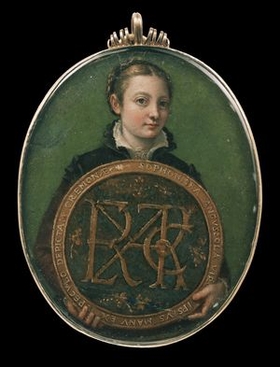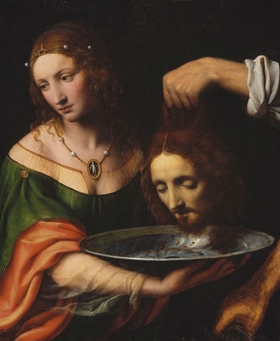Boston
What is Cleopatra, born in 69 B.C., doing in an exhibition titled "Strong Women in Renaissance Italy"? And why do the Queen of Sheba (10th century B.C.), Judith (sixth century B.C.), Salome and Mary Magdalene (both A.D. first century) also figure prominently?
 Anguissola's Self-Portrait |
Instead of focusing on the few increasingly famous names, the curator, Marietta Cambareri, aims to show that others in 14th- to early 17th-century Italy also surmounted restrictions that confined most women to home, church and family visits. Some became writers, musicians, healers, or lace and textile makers, while others exerted influence as patrons and devotional leaders. Moreover, she asserts, attitudes toward women, past and present, were shifting—prompting male artists like Pier Jacopo Alari Bonacolsi, known as Antico, to portray Cleopatra positively, not as a lustful schemer, and Bernardino Luini to paint "Salome With the Head of St. John the Baptist" (1515-25) with her looking away, troubled, not pleased, by the murder she had requested at the behest of her vengeful mother.
 Isanella D'Este's crest at the center |
The 100 paintings, engravings, books, lace fragments, textiles, embroideries and other objects on view—nearly a quarter of which are documented as by women or thought to be so—are organized thematically, in sections about female accomplishments as well as their daily life.
 Luini's Salome |
Several representations of Mary Magdalene cast her in a positive light, rather than repeating the discredited notion that she was once a prostitute. Bernardo Daddi's gold-ground "The Crucifixion" (before 1328) gives her a dominant role—dressed in intense red, with a bright halo, clinging to the cross at a time when most of Jesus' male followers had abandoned him. Others—especially an exquisite woven silk-and-satin fragment (14th-15th century) of the "Noli Me Tangere" scene, which shows her as the first person to whom the risen Christ appears and thus the first to spread the gospel—credit her as the first apostle.
 Cut-straw casket |
"Strong Women" is full of other such insights. But, strangely, not a single female creator emerges as a "strong woman." Small paintings by Gentileschi, Anguissola, Fontana and Barbara Longhi hang in an alcove near the entrance. But only Anguissola's expressive self-portrait (c. 1556) could be considered a masterpiece—and it's tiny, just over 3 inches tall.
 Mantuana engraving of Biblical scene |
Numerous portraits of Isabella exist, including a drawing by Leonardo da Vinci and a famous painting by Titian. Likewise, images of Colonna, Mantuana and Parasole exist and were certainly more lendable or reproducible. "Strong Women" offers visitors new ideas, but it would have benefited from fewer examples of historical revisionism and more about these women, their circumstances and personalities, and how they managed to thrive. A few more of their works, too.

